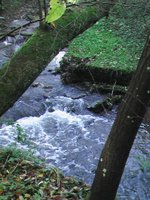 Continuing the history of the fictitious Körschtalbahn. To start at the beginning go here.
Continuing the history of the fictitious Körschtalbahn. To start at the beginning go here.
In 1945 anyone could see that the railway was severely run down. The one remaining Mallet had kept going in the final months of the war, as the generating equipment spent more time broken than operable, and the railcars were so worn out they sagged in the middle. A daily mixed train had run each way during the war but it was alarmingly apparent that the track was highly unstable, straight sections having taken on the appearance of a length of wet spaghetti. None of the signals worked and once a train disappeared up the valley no one knew where it was. There was nothing anyone could do except hope it would make it back sometime, and on at least one occasion the passengers spent an uncomfortable night on board as the crew pulled the mallet back on the track. All services stopped a week after the end of the war. The line lay unused until it became clear that permanent closure was not an option and the occupying French forces made enough repairs for a limited steam hauled service to run as far as Dachsburg by Christmas 1945, with trains returning to Spitzenwald in summer 1946.
As the “economic miracle” took place in West Germany the line found itself carrying more traffic. For a while the new Deutsche Bundesbahn dragged its feet on investment, but eventually the State of Baden-Württemberg stepped in and funded repairs to the permanent way and overhead wires, and a new electric railcar. Someone somewhere was pushing for electric operation to Spitzenwald: a study was carried out in the late 50’s but nothing came of it, and a used diesel was bought at the end of the decade to replace the two war era locomotives. It was joined by a MAN diesel railcar, either second or third hand -nobody was entirely sure- but it behaved well and growled its way through the upper valley every day with a couple of freight wagons in tow.
On June the 28th 1961 the line bade farewell to steam as part of the 60th anniversary celebrations, and promptly began running a summer tourist service with the Mallet a year later. In the mid 60’s the road to Dachsburg and beyond was rebuilt, but no amount of rebuilding could quite straighten it out and the railway continued to offer a competitive journey time. By now the line was operating a daily passenger service with the main peak in the morning, a school service mid-afternoon and a second smaller peak in the early evening as people returned from Wildberg and beyond.
On paper the line seemed secure, but already there were clouds on the horizon: ever more trucks were coming into the Körschtal, causing damage and pollution to the pristine valley, and undercutting the railway. The Körschtalbahn management and local towns had been clamouring for investment in freight transfer facilities, seeing that an ability to handle containers would be vital to the line’s future, but all was in vain. As the 1970’s drew to a close DB seemed deaf to all requests and calls for improvements, even when the local governments offered to foot the bill. It seemed that the national railway company was uninterested in further work on narrow gauge railways and quite happy to allow the Körschtalbahn run into the ground.
(
To be continued)




